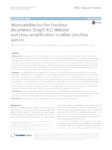Use este identificador para citar ou linkar para este item:
http://www.alice.cnptia.embrapa.br/alice/handle/doc/1062128Registro completo de metadados
| Campo DC | Valor | Idioma |
|---|---|---|
| dc.contributor.author | FERREIRA, R. C. U. | pt_BR |
| dc.contributor.author | CANÇADO, L. J. | pt_BR |
| dc.contributor.author | VALLE, C. B. do | pt_BR |
| dc.contributor.author | CHIARI, L. | pt_BR |
| dc.contributor.author | SOUZA, A. P. de | pt_BR |
| dc.date.accessioned | 2017-01-30T11:11:11Z | pt_BR |
| dc.date.available | 2017-01-30T11:11:11Z | pt_BR |
| dc.date.created | 2017-01-30 | pt_BR |
| dc.date.issued | 2016 | pt_BR |
| dc.identifier.citation | BMC Research Notes, v. 9, n. 152, p. 1-11, 2016. | pt_BR |
| dc.identifier.uri | http://www.alice.cnptia.embrapa.br/alice/handle/doc/1062128 | pt_BR |
| dc.description | Background: Forage grasses of the African genus Urochloa (syn. Brachiaria) are the basis of Brazilian beef production, and there is a strong demand for high quality, productive and adapted forage plants. Among the approximately 100 species of the genus Urochloa, Urochloa decumbens is one of the most important tropical forage grasses used for pastures due to several of its agronomic attributes. However, the level of understanding of these attributes and the tools with which to control them at the genetic level are limited, mainly due to the apomixis and ploidy level of this species. In this context, the present study aimed to identify and characterize molecular microsatellite markers of U. decumbens and to evaluate their cross-amplification in other Urochloa species. Findings: Microsatellite loci were isolated from a previously constructed enriched library from one U. decumbens genotype. Specific primers were designed for one hundred thirteen loci, and ninety-three primer pairs successfully amplified microsatellite regions, yielding an average of 4.93 alleles per locus. The polymorphism information content ( IC) values of these loci ranged from 0.26 to 0.85 (average 0.68), and the associated discriminating power (DP) values ranged from 0.22 to 0.97 (average 0.77). Cross-amplification studies demonstrated the potential transferability of these microsatellites to four other Urochloa species. Structure analysis revealed the existence of three distinct groups, providing evidence in the allelic pool that U. decumbens is closely related to Urochloa ruziziensis and Urochloa brizantha. The genetic distance values determined using Jaccard?s coefficient ranged from 0.06 to 0.76. Conclusions: The microsatellite markers identified in this study are the first set of molecular markers for U. decumbens species. Their availability will facilitate understanding the genetics of this and other Urochloa species and breeding them, and will be useful for germplasm characterization, linkage mapping and marker-assisted selection. Keywords: Enriched library, Forage, Signalgrass, Simple sequence repeat, Transferability | pt_BR |
| dc.language.iso | por | pt_BR |
| dc.rights | openAccess | pt_BR |
| dc.subject | Enriched library | pt_BR |
| dc.subject | Transferability | pt_BR |
| dc.title | Microsatellite loci for Urochloa decumbens (Stapf) R. D. Webster and cross-amplification in other Urochloa species. | pt_BR |
| dc.type | Artigo de periódico | pt_BR |
| dc.date.updated | 2017-03-02T11:11:11Z | pt_BR |
| dc.subject.nalthesaurus | Forage | pt_BR |
| dc.subject.nalthesaurus | Urochloa brizantha | pt_BR |
| dc.subject.nalthesaurus | Microsatellite repeats | pt_BR |
| riaa.ainfo.id | 1062128 | pt_BR |
| riaa.ainfo.lastupdate | 2017-03-02 | pt_BR |
| dc.contributor.institution | REBECCA, C. U. FERREIRA, UNICAMP; LETÍCIA J. CANÇADO; CACILDA BORGES DO VALLE, CNPGC; LUCIMARA CHIARI, CNPGC; ANETE P DE SOUZA, UNICAMP. | pt_BR |
| Aparece nas coleções: | Artigo em periódico indexado (CNPGC)  | |
Arquivos associados a este item:
| Arquivo | Descrição | Tamanho | Formato | |
|---|---|---|---|---|
| MicrosatellitelociforUrochloa.pdf | 1,01 MB | Adobe PDF |  Visualizar/Abrir |









